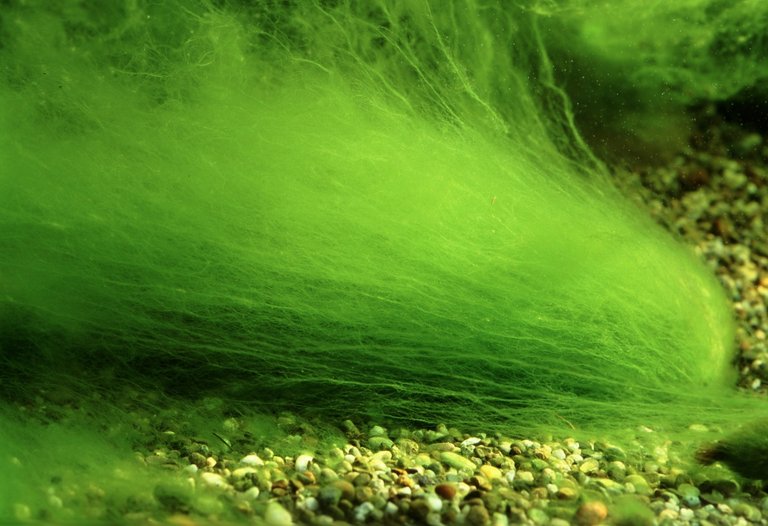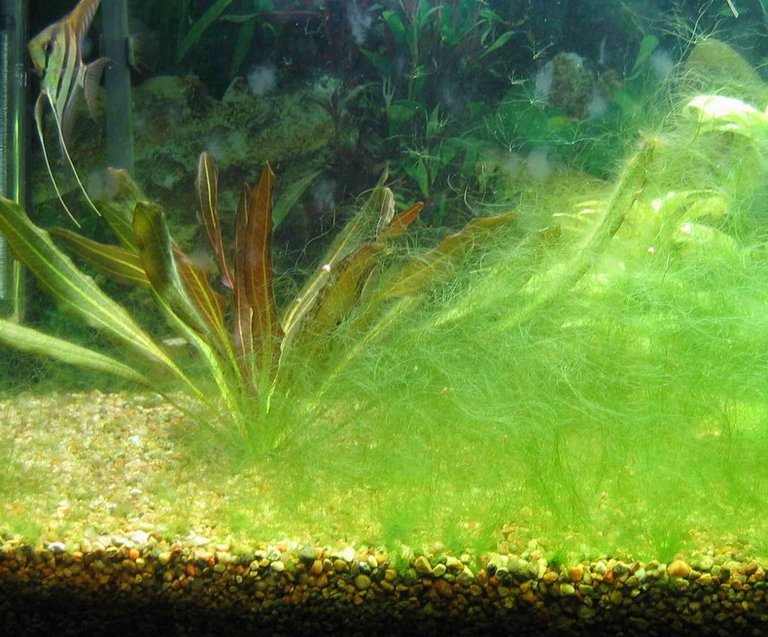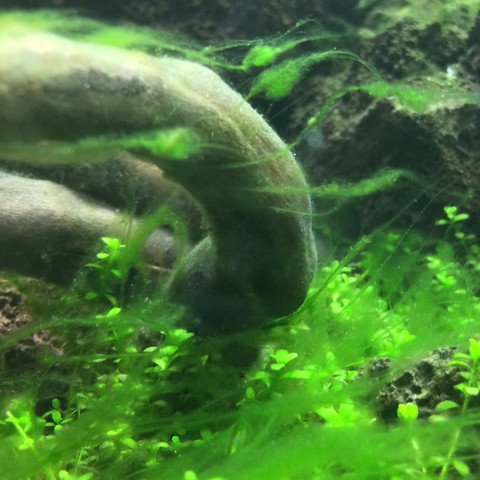filamentous algae

Typical filamentous algae are long-threaded green algae that feel quite soft and loose. Sometimes they disintegrate directly, if you try to cut a tuft. You can count to different types of algae. Natural predators such as the Amano shrimp like to eat this type of algae. Filamentous algae do not grow on material and anchor themselves there with special adhesive organs, but rather form bushy upholstery. In strong currents, individual threads drift through the water and then remain attached to objects or plants in order to continue to grow there.

Common causes
Quite often these algae appear in the run-in phase of a plant aquarium. In the first few weeks of a newly established basin, microbiology is still in an unbalanced state. With more service life, the ecosystem then runs more stable. Also, the balance between algae and aquatic plants at the beginning has not adjusted properly. Through stronger growth and increase in biomass, the plants then gain the upper hand over time. Important is therefore a lush plantation from the beginning, especially with fast-growing stem plants. For this purpose, a complete nutrient supply of aquatic plants by liquid fertilizer addition and CO2 supply is needed. For orientation, target values for the mentioned plant nutrients are listed here:
A CO2 content of about 20-30 mg / l, measurable by a long-term test including test reagent
10 to 25 mg / l nitrate (NO3)
5 to 10 mg / l potassium (K)
0.1 to 1 mg / l phosphate (PO4)
less than 10 mg / l magnesium (Mg)
At the beginning, add only one-third of the amount recommended by the manufacturer to the iron fertilizer
In the beginning, the aquarium is lit only for 6 hours a day. The duration can then be increased by about 30 minutes per week. If the pool is equipped with medium to strong lighting, we recommend lighting phases of about 8 to 10 hours duration. With weaker lighting, this can be extended to 10 to 12 hours.
A sudden algae outbreak in a plant aquarium can also be triggered by an imbalance of nutrients. Frequently, a lack of nitrate or CO2 is the cause, or too strong light due to lighting changes, daylight or too long light phases.
We will now take a closer look at the most common causes:
CO2
The CO2 content should be checked with a continuous test including test liquid. Is the indicator liquid working correctly in the endurance test? This should be replaced regularly (every four to six weeks) to always show the correct shade. Optimum CO2 levels are 20 to 30 mg / l, which corresponds to a green hue of the test fluid.
Lightning
Too much light in relation to the planting can trigger the growth of filamentous algae. Were the lights or bulbs replaced? Enhancing the lighting should always be accompanied by an increase in nutrient intake. Also, the illumination intensity must match the requirements of aquatic plants. When changing the bulb you should not replace all of the fluorescent tubes all at once, but do it better with a time delay.
Does the aquarium seem to have significantly more daylight due to a change of location or due to seasonal reasons? This too can be a cause.
For moderate to strong illumination, the light phase should not exceed 10 hours. In less lit aquariums, the upper limit is set at about 12 hours.
Nitrate
Plant growth often quite often ceases due to the lack of nitrogen, which can be measured in the form of nitrate. Due to the stagnation in the growth of aquatic plants, algae can exploit the situation for propagation. The nitrate value (NO3) should be determined with a suitable water test. Target values for this nutrient are in the range of 10 to 25 mg / l. With liquid fertilizers, the nitrate content can be increased in a targeted manner without overly influencing other nutrient values such as potassium or phosphate. In order to maintain the nutrient level it is necessary to adjust the regular intake or daily application with a pure nitrate fertilizer.
Since nutrient imbalances can also be caused by neglected care measures, we especially point out that a regular water change is very important. We recommend a weekly exchange of water of at least 50% of the aquarium content. This also avoids that certain substances accumulate too much.
Fight algae
You have problems with thread algae? Here are a number of ways to deal with the situation.
First, the use of suitable predators in sufficient numbers is important. Invertebrates such as Amano Shrimp and Dwarf Shrimp species (such as Red Bees or Red Fire) will help you control this algae.
Even a temporary increase in the amount of algae-eating animals is a solution, especially if you own several aquariums. I recommend using significantly more animals, especially in the case of algae infestation in the run-in phase of an aquarium. After the end of the break-in phase, a better balance between algae and plants has also been achieved. Then you can reduce the stocking of predators and relocate.
Is the aquarium equipped with only a few or slow growing plants? Then I recommend that you use even more healthy and fast growing aquatic plants. This measure makes sense even if the old stock has been weakened by heavy algae infestation.
Are only a few, few places affected in the aquarium? Manually, this algae can be easily reduced by winding it on a rough wooden stick and removing it from the basin. In some cases, you can even simply vacuum them with the hose when changing the water. If the algae continue to re-emerge after removal, you can also treat them locally with anti-allergic agents such as Easy Carbo or hydrogen peroxide using the misting method.
Is the aquarium heavily affected by filamentous algae? A dark cure initially represents a rather gentle treatment of the aquarium for algae reduction.
If all other options do not work, the last option is a complete treatment with an anti-algant such as AlgExit or a cure with hydrogen peroxide. Many aquarists have had good experiences with these emergency measures in the control of algae. However, it should be noted that prolonged treatment with these agents also affects the microbiological balance and can throw it off track. Likewise, some aquatic plants can be damaged or greatly restricted in growth. Also, certain species may not tolerate treatment, such as all racing and antler snails in the case of an AlgExit cure. In this respect, a complete treatment is always to be understood only as the very last rescue measure.

Sources
https://www.algen-im-aquarium.de/fadenalgen-gruenalgen-bekaempfung-und-entstehung/
https://my-fish.org/anfanger-einstieg/algen/gruenalgen-chlorophyta/
https://www.gutefrage.net/frage/sind-das-fadenalgen
Congratulations @garnele! You have completed some achievement on Steemit and have been rewarded with new badge(s) :
Click on any badge to view your own Board of Honor on SteemitBoard.
For more information about SteemitBoard, click here
If you no longer want to receive notifications, reply to this comment with the word
STOP